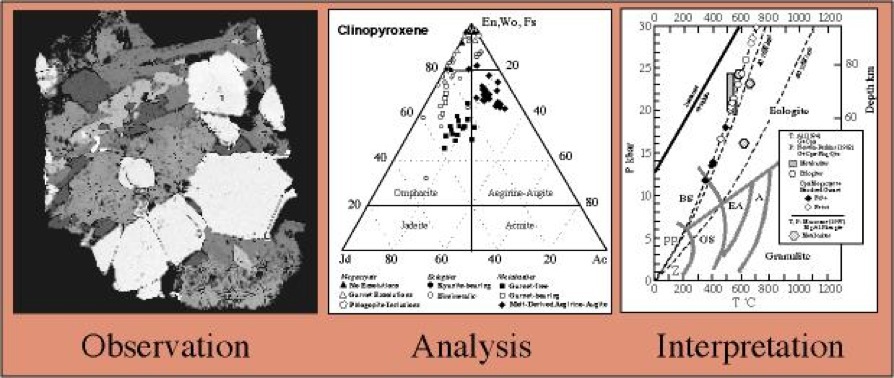General Info
The purpose of this class is to provide the student with the necessary information and training to become an independent and proficient microprobe/SEM user. The class will cover various aspects of electron beam - sample interaction, the operation of various pieces of microprobe hardware, and last but not least, how to utilize theory and hardware to obtain quantitative analyses of solids. Don't worry, if you can think and have common sense this will be easy. The lectures will be about 1-1.5 hours, twice a week (WF 8:30-10:30am). On Wednesday, the lecture will be followed by ~1 hour lab demonstration. The lecture/demo section is supplemented by a series of independent 3 hour labs to learn proper use of the department's JEOL 733 microprobe. To ensure that each student obtains adequate machine time, each lab section will be limited to a maximum of 3 students, but preferably 2 students. Some of this will depend on the number of students enrolled in the class and when the lab times are scheduled. This class is offered WINTER QUARTER only.
Lecture Topics
-
1.Introduction
-
2.Sample Current, Secondary Electrons, Backscattered Electrons
-
3.Electron Gun
-
4.Electromagnetic Lenses
-
5.Characteristic X-rays
-
6.Characteristic X-rays, Auger Electrons
-
7.Background Radiation
-
8.Sample Heating, Cathodoluminescence
-
9.Bragg Equation and X-ray Diffraction
-
10.Wavelength Spectrometers
-
11.MIDTERM EXAM
-
12.Vacuum Systems
-
13.Origin of ZAF Corrections
-
14.Bence/Albee - Armstrong Corrections
-
15.Errors
-
16.Secondary and Backscattered Detectors
-
17.Si(Li) EDS Detectors
-
18.WDS Detectors
-
19.Field Trip (SEM/STEM lab)
Weekly Lab Topics:
-
1.Introduction, lab procedures, and demonstration
-
2.Loading samples and manipulating the probe using dSspec
-
3.Filament saturation, column alignment, and SEM imaging
-
4.The energy dispersive spectrometer system (EDS)
-
5.The wavelength dispersive spectrometers (WDS)
-
6.Quantitative WDS analysis using dQant automation
-
7.Miscellaneous: X-ray mapping demo, more WDS analyses
-
8.Individual projects
-
9. Individual projects
-
10. Individual projects
Field Trips:
For the final class we will visit a Scanning Transmission Electron Microscope (STEM) Lab in the Physics-Astronomy Department and look a particles from outer space.

